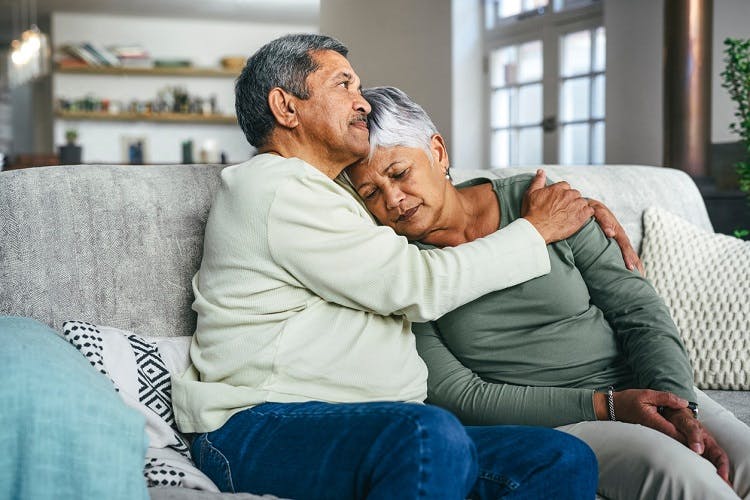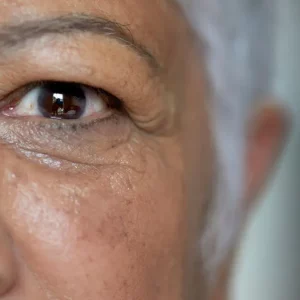Grief after stroke is a challenge that many survivors and caregivers face. When your life changes overnight, it’s only natural to feel grief – and everyone experiences it differently.
After a stroke, it helps to understand the stages of grief that you may go through. Through self-understanding and healthy coping mechanisms, you can help yourself reach the last stage of grief, which is acceptance.
In this article, you will learn:
- Why grief happens after a stroke
- What the stages of grief are
- How you can cope with grief after stroke
Understanding Why Grief Happens
Many of us are accustomed to thinking of grief as the deep sorrow we feel after the death of a loved one. What many of us don’t realize, however, is that grief can be triggered by a substantial loss of any kind – including those that happen after a stroke.
For many survivors, a stroke is a life-changing event that involves different kinds of loss. Certain abilities, such as talking and walking, can be compromised. Even though rehabilitation can help restore many abilities, this takes time, consistency, and hard work. Thus, survivors may experience feelings of loss around their old life, abilities, dreams, and even sense of identity.
To better understand how a stroke can cause grief, let’s look at an example of a professional guitar player that earns a living by making music. If a stroke compromised her hand function, she may lose the ability to play guitar and, as a result, struggle with the loss of a career and a beloved hobby. Not only can this challenge her identity, but the physical impairment may also lead to lowered feelings of self-efficacy, poor self-esteem, and grief.
To cope with the feelings of loss following stroke, it can help to understand what the stages of grief look like. This way, you are aware of different mental and emotional challenges you may face on the road to recovery.
The Stages of Grief After Stroke
Grief is commonly thought to occur in five stages as first described by psychiatrist Elisabeth Kübler-Ross. Her 5-stage grief framework, first created in 1969, has been well-received by some and later criticized by others for being inaccurate and outdated.
Try not to look at these stages as a rigid outline of grief, which is often a messy process. Instead, know that the stages of grief are often experienced out of order and this journey will look different for everyone. Understanding how grief can appear after stroke is a valuable tool to help you recognize and process the complicated feelings you may face.
With that said, here’s an overview of the 5 stages of grief and how they relate to stroke recovery:
Stage 1: Denial
A stroke can be a life-altering event that completely changes many aspects of daily life for both the survivor and their caregiver or family. After the initial complications of stroke have been treated, you might have moments (or even days) of denial, where you’re in utter disbelief that this event happened.
Many stroke patients find themselves thinking, “I never thought something like this would happen to me.” Additionally, some survivors may have difficulty accepting that many of their daily activities or hobbies will be inaccessible or require modifications.
Denial is a common feeling for survivors after stroke, but if denial persists, this could be a sign of a condition known as anosognosia. Anosognosia refers to an unawareness of deficits following injury to the brain, which can be a major obstacle during the stroke recovery process. While individuals experiencing denial will avoid accepting their situation because it is unpleasant or upsetting, a survivor with anosognosia will be unable to recognize that a problem exists at all.
Stage 2: Anger
Anger is another stage of grief that a survivor may face after stroke. Remember that the different stages of grief may not be experienced in order. This means anger might not happen right after denial – although it can.
Anger after stroke can be triggered by different factors. A survivor could be frustrated that everyday tasks suddenly take enormous effort or that they experienced a life-changing event they didn’t ask for. Additionally, there may be other stressors that induce anger, such as limited insurance coverage for rehabilitation or a change in independence or family relationships.
If you struggle with anger after stroke, it’s important to have healthy coping mechanisms in place. This can include techniques such as deep breathing, getting outside in nature, or participating in psychotherapy. If anger turns into aggressive behavior, you may need extra help, such as talking to your doctor about possible medication.
Stage 3: Bargaining
Bargaining is an interesting stage of grief. It occurs when you start making deals with a higher power through if/then statements. For example, this may sound something like “if only I could move my leg again, then I would be a better person.” This stage can also be difficult for survivors to navigate as they may feel they could have avoided the stroke by changing their actions or behaviors.
Since the stages of grief are not linear, it’s possible that some people will skip this step or find themselves revisiting this pattern often. Regardless of if/when you experience bargaining, this can be a helpful step if it inspires action. Results are made through action and, if bargaining with a higher power helps motivate you to participate in rehab, this could be a productive stage of grief.
However, if your bargains seem to go unanswered, don’t let this stop you from pursuing rehabilitation. Stroke recovery is not linear, but you can always continue to push for recovery. Intentional, consistent practice is necessary to improve your skills and increase your independence.
Stage 4: Depression
The fourth stage of grief is depression, which is commonly experienced by survivors after stroke. In fact, post-stroke depression affects one third of stroke survivors at any one time. This is understandable as stroke can affect so many aspects of daily life.
Depression can be a difficult stage of grief to move through and can also be experienced at many points during the recovery journey. However, you must continue to move through it because the only way out is through.
If you experience depression after stroke, it can help to know that it’s normal and should improve with time and by practicing healthy habits (such as participating in psychotherapy). Talk with your doctor and rehab team to discuss what options are available to you to help navigate depression and grief after stroke.
Finding a stroke support group can be beneficial by connecting you with other survivors who are experiencing similar journeys or feelings. Additionally, reading uplifting self-help books like Healing & Happiness After Stroke can be helpful for many survivors. No matter what, keep participating in rehabilitation to push for the higher recovery you deserve.
Stage 5: Acceptance
The final stage of grief is acceptance. This stage refers to the point at which you have accepted your current situation and found your “new normal.”
During this stage, you will find yourself becoming accepting towards your recovery journey. You know progress will continue to require hard work, but you’ve accepted where you are and are eager to keep moving forward.
Even after reaching acceptance, you may have days or weeks where you slip backwards into other stages grief. Since you’ve reached acceptance once, however, you can have faith that you will reach it again. To help you reach this stage of recovery, we will discuss some tips for navigating grief after stroke.
Tips for Managing Grief After Stroke
Knowing the stages of grief is a great step towards managing and working through the complex emotions commonly experienced after stroke. It can be helpful and even relieving to understand what feelings you might experience and to know that these feelings are normal and valid.
Along with self-understanding, you can try the following tips to help cope with grief after stroke:
- Participate in psychotherapy. We’ve mentioned this several times already because it’s arguably the most helpful intervention for navigating grief after stroke. Therapists are trained to help people process feelings of loss and grief. Having the ability to express your feelings without judgment can promote immense growth and provide relief.
- Find an outlet. Since anger is one of the stages of grief, it’s important to have an outlet available to vent frustration. Some people find it helpful to watch a comedy because humor helps break the cycle of angry emotions. You can also explore a new hobby or pastime, such as listening to music, crafting, or meditating. Do whatever you need to safely avoid any aggressive behavior after stroke.
- Keep a journal. Write down how you’re feeling on good days and bad days. This will create a helpful log of how you’re doing as well as the progress you’ve made. Then, when things feel dark, you can look back and remind yourself that things usually go up after they’ve been down. If writing is difficult, you can also record an audio journal.
- Stick with a consistent rehab regimen. The physical side of rehabilitation can often help with the emotional side. For example, it can be motivating to see progress and reach physical goals you set for yourself. The more you improve, the more hope and optimism you will feel towards recovery.
- Get daily exercise and fresh air. Getting regular physical exercise can not only reduce the risk of experiencing another stroke, but can also improve mental and emotional health. Additionally, getting outdoors can be a huge boost for mental and emotional wellbeing. Whether you are walking independently or navigating with the help of a wheelchair, spending time in nature is a valuable tool for recovery.
- Read more about emotional healing. The emotional side of stroke recovery doesn’t get as much attention as the physical side. For this reason, it’s important to seek more information. The book Healing & Happiness After Stroke is a great resource. It discusses the emotional side of stroke recovery including tips to cope with grief, reestablish your identity, and boost self-esteem.
Navigating Grief After Stroke
Grief is a complex but normal part of the recovery process after stroke. This is because the secondary effects of stroke often cause substantial losses or changes in daily life for a survivor. Feelings of loss, denial, and depression are commonly experienced after stroke, but these feelings will not be permanent if you continually work to understand and move past them.
By keeping up with healthy habits such as psychotherapy and daily rehab, you can stay on track towards recovery. With time and help from your loved ones and rehab team, you can reach the final stage of grief: acceptance. The road to recovery is never linear, but as you keep putting one foot in front of the other, you will see improvement over time.















